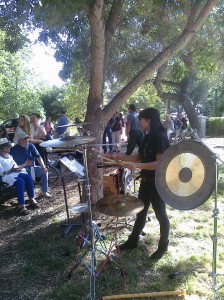[youtube QinQ1gkLWpU]
A bit past the halfway mark in Richard Wagner’s Siegfried Idyll comes a passage marked “Lebhaft” (lively tempo). It begins with a bright, energetic horn fanfare that is quickly answered by bird calls in the flute and clarinet. The flow of the piece makes it sound like Siegfried – Wagner’s son as much as his character – has awoken from gentle slumber to find himself in the woods. But there was nothing like that sensation when Alarm Will Sound played the original sinfonietta version last Friday to open their “The Permanent Collection” concert, which itself opened their new residency at the Metropolitan Museum of Art.
Limor Tomer is remaking the Met into the most interesting performance space in the city, with programming that rivals that of Miller Theatre and the use of the gallery spaces for live music. Alarm Will Sound has some great programming on tap, including an all Steve Reich concert November 16, but Alan Pierson and the group choose to set their first concert in the museum’s physical collection by showing the roots of their ensemble. Pierson hints at something of an argument about the sinfoniette being the prototypical new music ensemble, which is sort of true and sort of not – it depends on what year you’re look from, and which direction you turn your attention.
Wagner was certainly making new music in the nineteenth century, but that’s not what the Idyll is. It’s one of his loveliest works, but the aesthetic is entirely different than that of the new music movement that began around a hundred years ago. The music is about cadences, modulations between chords and tempos and the gestural language used to effect those. That’s where the expression is, and Alarm Will Sound is steeped in the aesthetic of non-narrative expressive language. They strung along the notes, played nicely, but had nothing much to say about the actual music. It had me searching for my recording of Glenn Gould conducting an intellectually critical and lovely take with the same forces.
Thomas Adés Living Toys is more in their style, but only superficially. I’m not a fan of the music, or his work in general. I find his composing masks an ordinary romantic sensibility in a lot of bravura hand-waving material that, if it doesn’t amount to something ordinary, amounts to little at all. There is a mismatch between the density of musical activity and the density of thinking. It suffered in inevitable comparisoin with all the great pieces from John Zorn I heard last month, music that is overwhelming with both detail and musical, aesthetic and intellectual meaning. But Adés is more old music in new music clothes.
Truly new, and truly excellent, were Ligeti’s Chamber Concerto and Ragtime Dances 1 and 4 by Charles Ives. These works are at the heart of Alarm Will Sound’s purpose, music that explores the possbilities of the future and that was written with experimental values at the fore. Ligeti’s work comes from his cloud phase, a period when he heard music as something like a collection of webs, gossamer strends connecting to each other across distances and forming sections that fill in space with a tantilizing wispiness. This was a beautiful, concentrated performance, the music clearly excites the players’ interest and concentration, everything focussed and spooky. The Chamber Concerto doesn’t tell stories, and it displays instrumental prowess in subtly challenging ways, the results tickle the bass of the skull in rare ways.
The Ives’ dances are rarely played or recorded, which is a shame because they are brilliant and practical, distilled and sharply written examples of his art and his importance. Ives was always pinning popular tunes to his pieces, but there’s something about hearing him create and lay out his own ragtime beat that is revelatory. True to form, he fractures it deliberately and exuberantly, and like a pinata, the yield is delight, joy and real, substantial satisfaction.
Q2 will have the concert archive available to stream, check their site for availability

